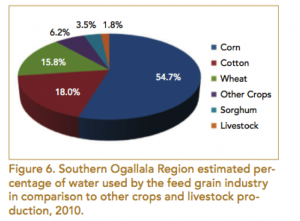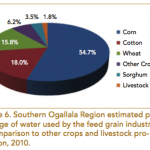Feed Grain Production & Water Use – Irrigated feed grain production on approximately 3.5 million acres has led this industry to being the largest single user of water from the Southern Ogallala Region. Agriculture accounts for more than 90 percent of the water use in the region each year. The feed grain industry’s demand for water has local leaders concerned about whether feed grain production in the region is an appropriate use of these scarce water resources. As we enter an era where conservation is key a new way of thinking is necessary. Rather than assessing profit margins on a per acre basis, more focus should be shifted to profits per-inch, as future water demands will likely place more emphasis on drought tolerant traits. Sorghum, a crop known for its water sipping qualities is already ahead of the conservation curve.
 Irrigated feed grain water use was estimated by using information from the 2012 Texas Crop and Livestock Enterprise Budgets regarding yields and irrigation applied per acre. These budgets are developed pro forma, assuming average rainfall will occur. The crop yield was divided by the irrigation applied to estimate the average production per acre-inch of water applied. Total water applied was estimated by dividing the irrigated crop production by the respective production per acre-inch.
Irrigated feed grain water use was estimated by using information from the 2012 Texas Crop and Livestock Enterprise Budgets regarding yields and irrigation applied per acre. These budgets are developed pro forma, assuming average rainfall will occur. The crop yield was divided by the irrigation applied to estimate the average production per acre-inch of water applied. Total water applied was estimated by dividing the irrigated crop production by the respective production per acre-inch.
 There is no question that pressure for more drought tolerant crops will continue. Due to the shifted focus, even as irrigated feed grain acreage is projected to gradually shift to dryland, overall production is expected to remain stable as production per acre-inch of water should improve. This information was gathered from the Texas A&M AgriLife report, “AG-011: The Impact of the Feed Grains Industry in the Southern Ogallala Region”.
There is no question that pressure for more drought tolerant crops will continue. Due to the shifted focus, even as irrigated feed grain acreage is projected to gradually shift to dryland, overall production is expected to remain stable as production per acre-inch of water should improve. This information was gathered from the Texas A&M AgriLife report, “AG-011: The Impact of the Feed Grains Industry in the Southern Ogallala Region”.
Drought Tolerant Corn Hybrids Tapping a Deeper Soil Profile – Texas A&M AgriLife Research scientists in Amarillo are wrapping up a two-year study on “Water Use and Grain Yield in Drought-Tolerant Corn in the Texas High Plains“. Dr. Qingwu Xue, his research assistant Dr. Baozhen Hao, and many other team members compared two hybrids from Pioneer in the study. “One is 33D49, a very popular conventional hybrid in the Texas High Plains that doesn’t have the drought-tolerant trait, and AQUAmax P1151 HR, also from Pioneer, but with the drought-tolerant trait and in the market since 2012,” said Xue. The objective of the study was to compare water use and grain yield performance of the two corn hybrids at three irrigation levels. “Irrigation treatments consisted of 100 percent, 75 percent and 50 percent evapotranspiration requirements”, Hao said. Measurements included soil water content, soil water extraction, seasonal evapotranspiration, water-use efficiency, biomass and grain yield. “What we found was there was no difference in total evapotranspiration between the two hybrids, so they required a similar amount of water to produce corn; however, at the 50 percent evapotranspiration level, the drought-tolerant corn had a tendency to access more water from the deeper soil profile”, Xue said, “what we also found was in the AQUAmax hybrids, the yield was generally 10 to 15 percent higher than the traditional hybrid, especially in drought conditions such as the 50 percent evapotranspiration level. That’s a huge yield benefit under drought conditions.” Xue concluded, “what it means is the new AQUAmax hybrid has higher yield and higher water-use efficiency – up to 20 percent.”
FSA County Committee Elections – USDA is urging producers to vote in their current FSA County Committee elections. USDA mailed ballots on Nov. 3rd to eligible producers and ballots must be returned by Dec. 1st. If you did not receive a ballot and are eligible to vote, you may pick one up at your local USDA Service Center or FSA office. Elected committee members will take office on January 1, 2015. Committee members provide a connection between the local agricultural community and USDA. County committee members operate within official regulations designed so local input is provided on federal programs administered by FSA.
Sorghum Foodies – Sorghum, a crop that has traditionally taken a back seat to other commodities is beginning to get noticed, not only as a livestock feed but the ancient grain has also grabbed the attention of many foodies as a tasty and gluten free choice. Recently sorghum has been making headlines in numerous articles that have featured the grain in the kitchen. Most current, the Huffington Post ran a story titled “What is Sorghum? And Why is the South so Obsessed with it?” where the author highlighted the unique flavor and rich history that embodies sorghum. A handful of recipes starring sorghum accompany the article. To view the article, click here.
Sorghum has been gaining national attention in several media stories with titles including: “Sorghum: The Next Super Grain?“, “Is Sorghum Poised to ‘Really Take Off’ Soon?“, and “Sorghum’s Genetic Pipeline Stocked with Potential“.










